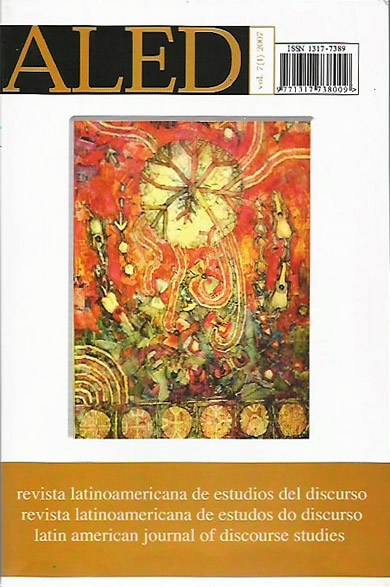Reconstruyendo los paradigmas orientales de los estudios del discurso
DOI:
https://doi.org/10.35956/v.7.n1.2007.p.79-94Keywords:
discourse studies. Eastern paradigms. Critical Discourse Analysis (CDA).subaltern communities. Chinese approach.Abstract
In this paper I argue that there are genuine reasons and important conditions for reconstructing Eastern paradigms of discourse studies, beyond the current universalistic but West-centric approaches. Firstly, I show Western limitations and human consequences of the proliferating project of Critical Discourse Analysis. Secondly and more importantly, I identify various characteristics of the discourses of Asia, Africa, Latin America and other subaltern communities, as well as relevant scholarly resources. To illustrate the strategies for this reconstructive work, finally, I consider the ways of forging a Chinese approach to its own as well as global discourses.
Downloads
References
ASANTE, M. K. (1998). The Afrocentric Idea. Revised and expanded ed. Philadelphia: Temple University Press.
BRADY, A-M. (2002). Regimenting the public mind: the modernisation ofpropaganda in the PRC. International Journal. 57 (4): 563-78.
CAREY, J.W. (1992). Communication as Culture: Essays on media and society. NewYork: Routledge.
CHEN G-M. (2004). The two faces of Chinese communication. HumanCommunication. 7: 25-36.
CHEN, G-M (2006). Asian communication studies: what and where to now. TheReview of Communication. 6 (4): 295-311.
CHEN G-M & W. J. STAROSTA (2003). Asian approaches to human communication:a dialogue. Intercultural Communication Studies. XII (4): 1-15.
CHESEBRO, J. (1996). Unity in diversity: multiculturalism, guilt/victimage, anda new scholarly orientation. Spectra. 32 (12): 10-14.
CHU, L.L. (1989). “In search of an Oriental communication perspective”, enChristian Academy (ed.). Continuity and Change in Communications in Post-Industrial Society, pp. 2-14. Seoul: Wooseok Publishing Co.
DISSANAYAKE, W. (ed.) (1988). Communication theory: The Asian perspective.Singapore: Asian Mass Communication Research and Information Center.
DISSANAYAKE, W. (2003). Asian approaches to human communication: retrospectand prospect. Intercultural Communication Studies. XII (4): 16-37.
FAIRCLOUGH, N. (1992). Discourse and Social Change. Cambridge: Polity Press.FANON, F. (1986). Black Skin, White Masks. Trans. C. L. Markmann. London:Pluto Press.
GERGEN, K. (1999). An Invitation to Social Construction. London: SagePublications.
GORDON, R. (1999). A spectrum of scholars: multicultural diversity and humancommunication theory. Human Communication. 2 (1): 1-8.
HEISEY, D. R. (ed.) (2000). Chinese Perspectives in Rhetoric and Communication.Stamford, CT: Ablex.
HIDALGO, M. (ed.) Mexican Indigenous Languages at the Dawn of the Twenty FirstCentury. The Hague: Mouton.
HORNBERGER, N. H. (ed.) Indigenous Literacies in the Americas: Language Planningfrom the Bottom Up. Berlin: Mouton de Gruyter.
ISHII, S. (2001). An emerging rationale for Triworld communication studies fromBuddhist perspectives. Human Communication, 4 (1): 1-10.
LAUF, E. (2005). “National diversity of major international journals in the fieldof communication”. Journal of Communication, March: 139-51.
LIN, A. N. (2001). “The great firewall”. Recuperado en 02/01/07: http://www.cpj.org/Briefings/2001/China_jan01/Great_Firewall.pdf.
LIU, Y. (1996). “To capture the essence of Chinese rhetoric: Anatomy of aparadigm in comparative rhetoric”, Rhetoric Review. 14 (1): 318-34.
KINCAID, D. L. (ed.) (1987). Communication Theory: Eastern and Westernperspectives. San Diego, CA: Academic Press.
MARTIN, J.N. & T.K. NAKAYAMA (2006). “Communication as Raced”, en G.J.Shepherd, J. St. John & T. Striphas (eds.), Communication as””: perspectiveson theory, pp. 75-83. London: Sage Publications.
MIIKE, Y. (2004). “Rethinking humanity, culture, and communication: Asiacentriccritiques and contributions”. Human Communication, 7 (1): 69-82.
MIIKE, Y. (2006). “Non-western theory in western research? An Asiacentricagenda for Asian communication studies”, The Review of Communication,6 (1/2): 4-31.
SHI-XU (2005). A Cultural Approach to Discourse. Houndmills/New York: PalgraveMacmillan.
SHI-XU (2006a). “Editorial: researching multicultural discourses”. Journal ofMulticultural Discourses. 1(1): 1-5.
SHI-XU (2006b). “A multiculturalist approach to discourse theory”. Semiótica.158 (1/4): 383-400.
SHI-XU (ed.) (2007). Discourse as Cultural Struggle. Hong Kong: Hong KongUniversity Press.
SHUTER, R. (2000). “Ethnics, culture, and communication: an interculturalperspective”, en L. A. Samovar & R. E. Porter (eds.), Intercultural Communication: A reader, pp. 443-50. Belmont, CA: Wadsworth PublishingCompany.
SPIVAK, G. C. (1988). In Other Words: Essays in cultural politics. New York:Routledge
STRATTON, J. & I. ANG (1996). “On the impossibility of a global cultural studies:‘British’ cultural studies in an ‘international’ frame”, en D. Morley & K-H.Chen (eds.), Stuart Hall, pp. 361-91.London: Routledge.
VAN DIJK, T. A. (1997). The Study of Discourse. Discourse Studies: a Multidisciplinary Introduction. Vol.1. pp. 1-34. London: Sage.
Downloads
Published
How to Cite
Issue
Section
License

This work is licensed under a Creative Commons Attribution-NonCommercial-NoDerivatives 4.0 International License.
The authors retain the copyright and guarantee RALED the right to be the first publication of the work as well as a Creative Commons Attribution License that allows others to share the work with recognition of authorship and the initial publication in this journal.




